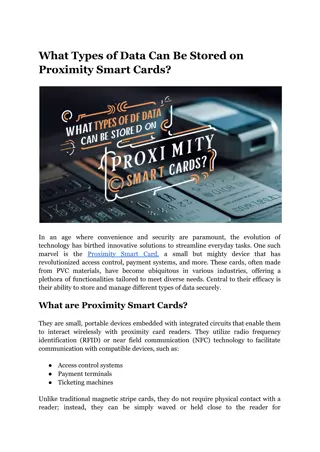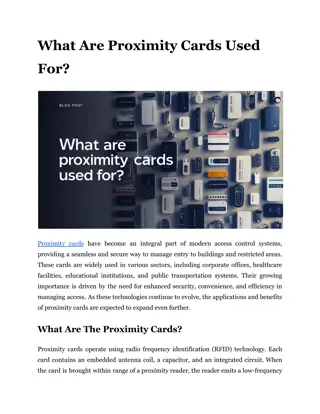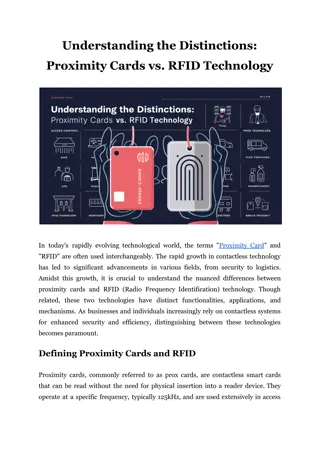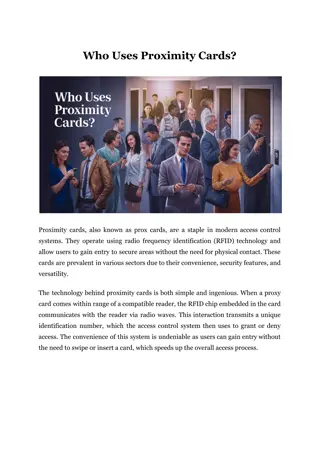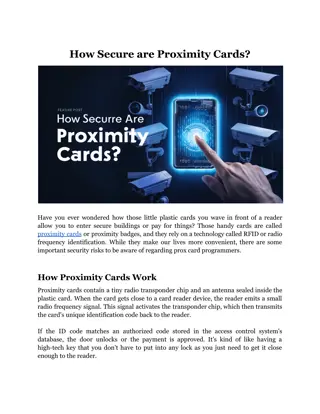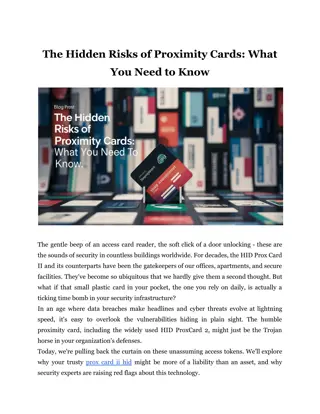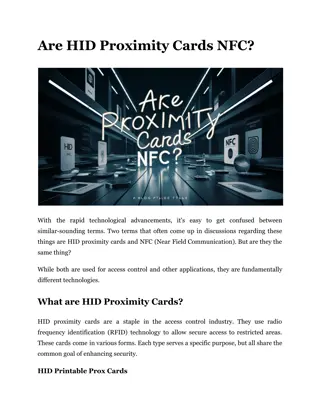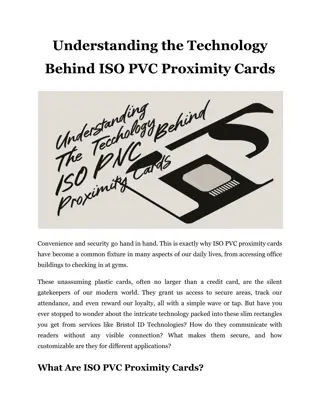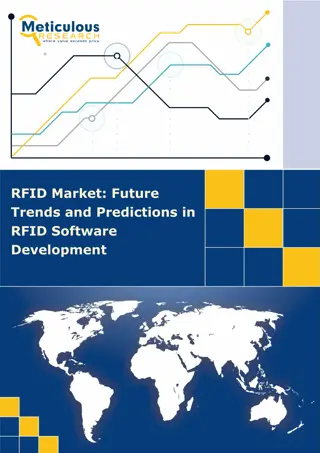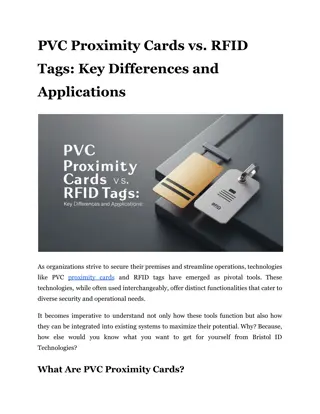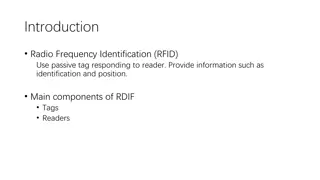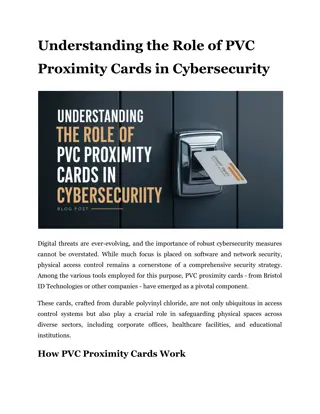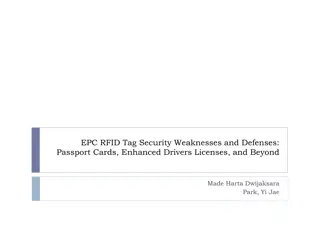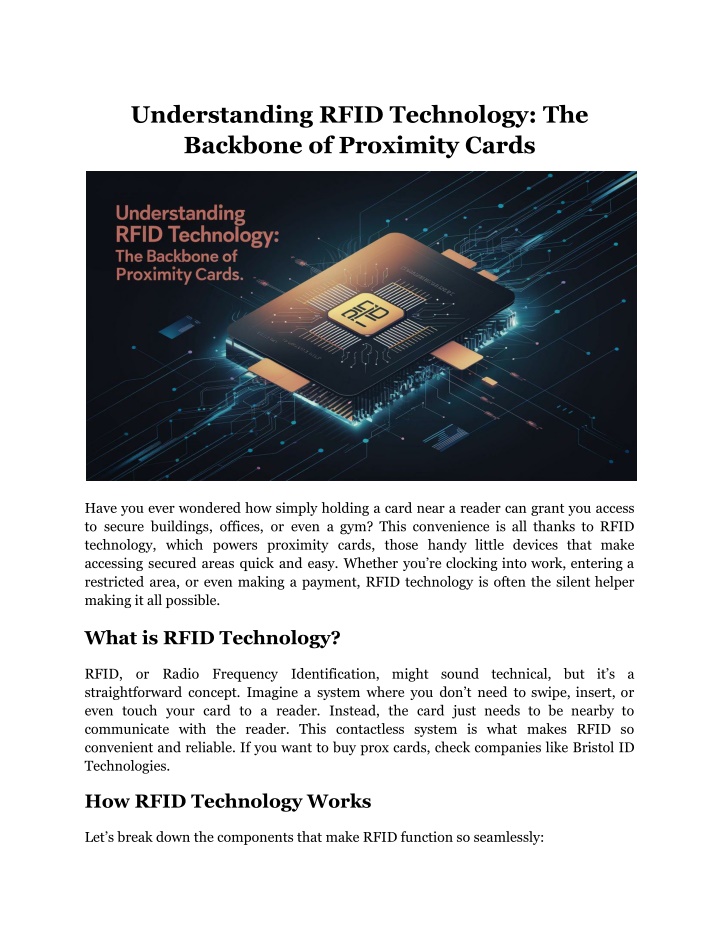
Understanding RFID Technology_ The Backbone of Proximity Cards
Discover how RFID technology powers proximity cards, making access control systems smarter and more secure.
Download Presentation

Please find below an Image/Link to download the presentation.
The content on the website is provided AS IS for your information and personal use only. It may not be sold, licensed, or shared on other websites without obtaining consent from the author. If you encounter any issues during the download, it is possible that the publisher has removed the file from their server.
You are allowed to download the files provided on this website for personal or commercial use, subject to the condition that they are used lawfully. All files are the property of their respective owners.
The content on the website is provided AS IS for your information and personal use only. It may not be sold, licensed, or shared on other websites without obtaining consent from the author.
E N D
Presentation Transcript
Understanding RFID Technology: The Backbone of Proximity Cards Have you ever wondered how simply holding a card near a reader can grant you access to secure buildings, offices, or even a gym? This convenience is all thanks to RFID technology, which powers proximity cards, those handy little devices that make accessing secured areas quick and easy. Whether you re clocking into work, entering a restricted area, or even making a payment, RFID technology is often the silent helper making it all possible. What is RFID Technology? RFID, straightforward concept. Imagine a system where you don t need to swipe, insert, or even touch your card to a reader. Instead, the card just needs to be nearby to communicate with the reader. This contactless system is what makes RFID so convenient and reliable. If you want to buy prox cards, check companies like Bristol ID Technologies. or Radio Frequency Identification, might sound technical, but it s a How RFID Technology Works Let s break down the components that make RFID function so seamlessly:
1. RFID Tag: This is the core of the proximity card. Inside this tag is a tiny microchip that stores information and an antenna that transmits this information to a reader. 2. RFID Reader: Think of the reader as the card s counterpart. It sends out a radio signal, which powers the RFID tag and prompts it to send back its stored information. 3. Antenna: The antenna in both the reader and the card tag enables communication between the two. It allows the card to transmit data to the reader over short distances without needing direct contact. This trio works together to create a secure, efficient way of transmitting data. It s why, when you hold a proximity card near a reader, the system can instantly verify your credentials and grant you access. Read More Article: How to Handle PVC Proximity Card Malfunctions: Tips and Solutions Why Proximity Cards are Essential for Access Control So, what makes proximity cards so popular in the world of access control? The answer lies in their unique combination of security, convenience, and durability. Security Without the Hassle One of the most significant advantages of proximity cards is how they manage to provide high levels of security while remaining incredibly convenient to use. you re good to go with a proximity card, you don t need to swipe or insert the card into a reader, just hold it close to the reader. This quick, contactless interaction not only speeds up access but also reduces wear and tear on the card itself. For instance, in a busy office environment, employees might access various secure areas multiple times a day. Proximity ID Cards simplify this process by allowing quick, secure access without any need for manual input or interaction. Plus, since each card has a unique ID, the risk of unauthorized duplication is minimal, ensuring that only authorized individuals can gain entry. Durability Means Long-Term Savings When it comes to cost-effectiveness, durability is a big deal. Proximity cards, especially those made from PVC, are designed to withstand the rigors of daily use. PVC Proximity Cards are resistant to damage from drops, bends, and frequent handling, which means
they last longer and dont need to be replaced as often. This longevity makes them a smart investment, particularly in environments where cards are heavily used. Consider a large company with hundreds of employees. Over time, the cost of replacing worn-out or damaged cards can add up. By opting for more durable options companies can reduce the frequency of replacements, leading to significant cost savings in the long run. Applications of Proximity Cards Across Industries Proximity cards are incredibly versatile and are used across various industries, each with its specific needs and requirements. Corporate Offices In corporate settings, security and efficiency are paramount. Proximity cards offer a seamless way for employees to access secure areas, clock in and out, and even access certain systems or data. In large corporations, where multiple layers of security are necessary, a Proximity Smart Card can also be used to provide multi-factor authentication, ensuring that only authorized information. personnel can access sensitive Educational Institutions Schools and universities often use Proximity ID Cards to manage access to buildings, dormitories, and other facilities. These cards also double as student IDs, providing a convenient, all-in-one solution for identification and access. The ability to quickly and easily update access permissions makes these cards ideal for academic environments where security needs can change frequently. Healthcare Facilities In healthcare, where both security and hygiene are critical, proximity cards provide a non-contact solution for accessing secure areas like operating rooms, pharmacies, and patient records. ISO PVC Proximity Card is particularly useful here, as it is durable enough to withstand constant use and can be easily sanitized. Read More Article: Understanding the Role of PVC Proximity Cards in Cybersecurity Government and Military
For high-security environments like government buildings and military installations, Prox Smart Cards offer the advanced security features needed to protect sensitive areas. These cards can be programmed with multiple layers of security, including encryption and biometric data, providing a robust solution for access control in critical environments. Industry Common Use Recommended Card Type Corporate Offices Access multi-factor authentication control, time tracking, Prox Smart Cards Educational Institutions Building access, student IDs Prox ID Cards Healthcare Facilities Secure access to sensitive areas, easy sanitization ISO PVC Prox Cards Government and Military High-security authentication access, multi-layer Prox Smart Cards Choosing the Right Proximity Card How do you choose the right proximity card for your needs? Here are some key factors to consider: Assess Your Security Needs Start by identifying the level of security required. If you need basic access control, Prox ID Cards may be sufficient. However, if you require more advanced security features like data storage or multi-factor authentication then Proximity Smart Cards are likely the better choice. Consider the Environment The environment in which the cards will be used plays a significant role in your decision. For example, in high-traffic or industrial settings, durability is crucial, so PVC prox cards would be ideal. In contrast, a corporate environment might benefit more from the added functionalities of a Prox Smart Card.
Evaluate Vendor Reliability Finally, it s essential to work with trusted proximity card vendors who offer quality products and support. A reliable vendor can help ensure that your cards are compatible with your existing systems and provide the necessary durability and security features. Conclusion So, the next time you use a proximity card to gain access to a building or secure area, you ll know just how much technology is working behind the scenes to keep you safe. It s a small device with a big role in ensuring security and efficiency in our everyday lives. Bristol ID Technologies is committed to providing top-tier identification solutions, ensuring that your access control needs are met with precision and reliability. From basic 125khz Proximity Card to advanced Prox Smart Card, we have the expertise and products to support your security infrastructure. Site Article: Understanding RFID Technology: The Backbone of Proximity Cards




